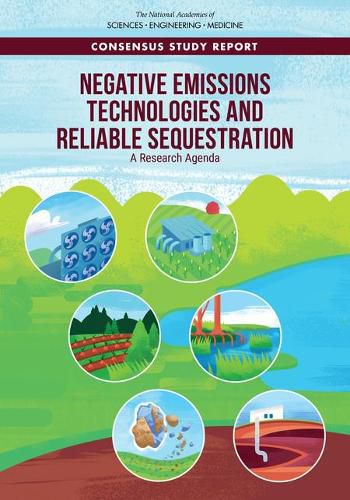Readings Newsletter
Become a Readings Member to make your shopping experience even easier.
Sign in or sign up for free!
You’re not far away from qualifying for FREE standard shipping within Australia
You’ve qualified for FREE standard shipping within Australia
The cart is loading…






To achieve goals for climate and economic growth, negative emissions technologies (NETs) that remove and sequester carbon dioxide from the air will need to play a significant role in mitigating climate change. Unlike carbon capture and storage technologies that remove carbon dioxide emissions directly from large point sources such as coal power plants, NETs remove carbon dioxide directly from the atmosphere or enhance natural carbon sinks. Storing the carbon dioxide from NETs has the same impact on the atmosphere and climate as simultaneously preventing an equal amount of carbon dioxide from being emitted. Recent analyses found that deploying NETs may be less expensive and less disruptive than reducing some emissions, such as a substantial portion of agricultural and land-use emissions and some transportation emissions.
In 2015, the National Academies published Climate Intervention: Carbon Dioxide Removal and Reliable Sequestration, which described and initially assessed NETs and sequestration technologies. This report acknowledged the relative paucity of research on NETs and recommended development of a research agenda that covers all aspects of NETs from fundamental science to full-scale deployment. To address this need, Negative Emissions Technologies and Reliable Sequestration: A Research Agenda assesses the benefits, risks, and sustainable scale potential for NETs and sequestration. This report also defines the essential components of a research and development program, including its estimated costs and potential impact.
$9.00 standard shipping within Australia
FREE standard shipping within Australia for orders over $100.00
Express & International shipping calculated at checkout
Stock availability can be subject to change without notice. We recommend calling the shop or contacting our online team to check availability of low stock items. Please see our Shopping Online page for more details.
To achieve goals for climate and economic growth, negative emissions technologies (NETs) that remove and sequester carbon dioxide from the air will need to play a significant role in mitigating climate change. Unlike carbon capture and storage technologies that remove carbon dioxide emissions directly from large point sources such as coal power plants, NETs remove carbon dioxide directly from the atmosphere or enhance natural carbon sinks. Storing the carbon dioxide from NETs has the same impact on the atmosphere and climate as simultaneously preventing an equal amount of carbon dioxide from being emitted. Recent analyses found that deploying NETs may be less expensive and less disruptive than reducing some emissions, such as a substantial portion of agricultural and land-use emissions and some transportation emissions.
In 2015, the National Academies published Climate Intervention: Carbon Dioxide Removal and Reliable Sequestration, which described and initially assessed NETs and sequestration technologies. This report acknowledged the relative paucity of research on NETs and recommended development of a research agenda that covers all aspects of NETs from fundamental science to full-scale deployment. To address this need, Negative Emissions Technologies and Reliable Sequestration: A Research Agenda assesses the benefits, risks, and sustainable scale potential for NETs and sequestration. This report also defines the essential components of a research and development program, including its estimated costs and potential impact.